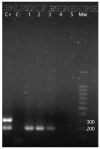Study of Zoonotic Pathogens in Alien Population of Veiled Chameleons (Chamaeleo calyptratus) in the Canary Islands (Spain)
- PMID: 37508064
- PMCID: PMC10376624
- DOI: 10.3390/ani13142288
Study of Zoonotic Pathogens in Alien Population of Veiled Chameleons (Chamaeleo calyptratus) in the Canary Islands (Spain)
Abstract
Veiled chameleons (Chamaeleo calyptratus) are native to the Arabian Peninsula that have been introduced as pets in many regions around the world, such as the Canary Islands (Spain). In this work, the gastrointestinal content from veiled chameleons of Gran Canaria island (Canary Islands) has been analyzed to determine the presence of zoonotic bacteria. Forty animals were analyzed using different selective culture media and PCR. The most isolated bacteria were Yersinia enterocolitica (52.4%), followed by Salmonella spp. (40.0%), with positive isolates for Salmonella Tyhpi and Salmonella Typhimurium. Pseudomonas spp. was found in 32.5% of the chameleons. More than half were positive for Pseudomonas aeruginosa. Antibiotic-resistant Staphylococcus spp. was detected in six animals plus one isolate of non-resistant Staphylococcus hominis. Multiple mycobacteria species belonging to both tuberculous and non-tuberculous complexes were identified as well as Escherichia coli carrying the stx1 and eae virulence genes with 12.5% and 7.5% prevalence, respectively. Listeria monocytogenes, Campylobacter spp., and Vibrio spp. were found in lower proportion (<5%). The results obtained indicate that veiled chameleons in Gran Canaria could be playing a role in the maintenance and dissemination of the pathogens detected, harming public health and biodiversity.
Keywords: Canary Islands; Salmonella; Yersinia enterocolitica; veiled chameleons; zoonotic bacteria.
Conflict of interest statement
The authors declare no conflict of interest. The funders had no role in the design of the study; in the collection, analyses, or interpretation of data; in the writing of the manuscript; or in the decision to publish the results.
Figures




Similar articles
-
Zoonotic Bacteria in Anolis sp., an Invasive Species Introduced to the Canary Islands (Spain).Animals (Basel). 2023 Jan 26;13(3):414. doi: 10.3390/ani13030414. Animals (Basel). 2023. PMID: 36766304 Free PMC article.
-
Ultrasonographic appearance of the coelomic cavity organs in healthy veiled chameleons (Chamaeleo calyptratus) and panther chameleons (Furcifer pardalis).Vet Radiol Ultrasound. 2020 Jan;61(1):58-66. doi: 10.1111/vru.12820. Epub 2019 Dec 3. Vet Radiol Ultrasound. 2020. PMID: 31794122
-
Fungal dermatitis, glossitis and disseminated visceral mycosis caused by different Metarhizium granulomatis genotypes in veiled chameleons (Chamaeleo calyptratus) and first isolation in healthy lizards.Vet Microbiol. 2017 Aug;207:74-82. doi: 10.1016/j.vetmic.2017.06.005. Epub 2017 Jun 10. Vet Microbiol. 2017. PMID: 28757044
-
Computed tomography of the coelomic cavity in healthy veiled chameleons (Chamaeleo calyptratus) and panther chameleons (Furcifer pardalis).Open Vet J. 2023 Sep;13(9):1071-1081. doi: 10.5455/OVJ.2023.v13.i9.2. Epub 2023 Sep 30. Open Vet J. 2023. PMID: 37842108 Free PMC article. Review.
-
Antibiotic Resistance in Selected Emerging Bacterial Foodborne Pathogens-An Issue of Concern?Antibiotics (Basel). 2023 May 9;12(5):880. doi: 10.3390/antibiotics12050880. Antibiotics (Basel). 2023. PMID: 37237783 Free PMC article. Review.
References
-
- Najberek K., Olszańska A., Tokarska-Guzik B., Mazurska K., Dajdok Z., Solarz W. Invasive alien species as reservoirs for pathogens. Ecol. Indic. 2022;139:108879. doi: 10.1016/j.ecolind.2022.108879. - DOI
-
- Ciencia Canaria—Invasoras: Las Especies Que Acechan en Las Islas. [(accessed on 21 April 2022)]. Available online: https://www.cienciacanaria.es/secciones/a-fondo/1174-invasoras-las-espec....
-
- Especies Exóticas Invasoras. [(accessed on 19 May 2022)]. Available online: https://www.gobiernodecanarias.org/medioambiente/materias/biodiversidad/...
-
- Efectos. [(accessed on 21 April 2022)]. Available online: https://www.gobiernodecanarias.org/medioambiente/materias/biodiversidad/...
Grants and funding
- agreement "Estudio de patógenos en aves migratorias y en especies exóticas en un escenario de cambio climático"/Consejería de Transición Ecológica, Lucha contra el Cambio Climático y Planificación Territorial" (Gobierno de Canarias)
- predoctoral scholarship of the training program TESIS2022010038/Department of Economy, Knowledge, and Employment of the Canary Government
- predoctoral scholarship of the training program TESIS2022010038/European Social Fund (ESF) 85% within the framework of the Canary Islands ESF Operational Program 2014-2020, priority axis 3, investment priority 10.2, specific object 10.2.1.
LinkOut - more resources
Full Text Sources
Miscellaneous

